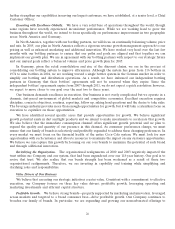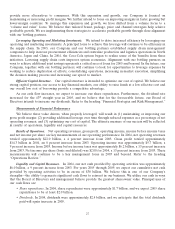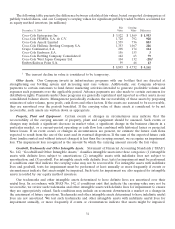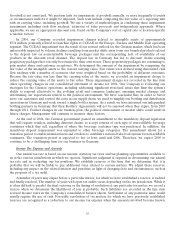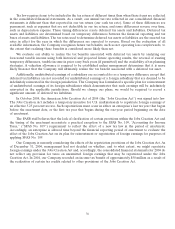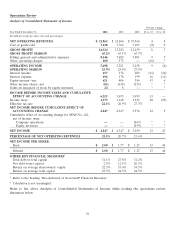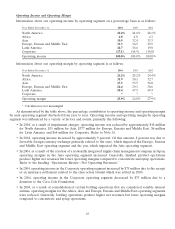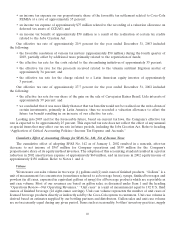Coca Cola 2004 Annual Report Download - page 38
Download and view the complete annual report
Please find page 38 of the 2004 Coca Cola annual report below. You can navigate through the pages in the report by either clicking on the pages listed below, or by using the keyword search tool below to find specific information within the annual report.Tax law requires items to be included in the tax return at different times than when these items are reflected
in the consolidated financial statements. As a result, our annual tax rate reflected in our consolidated financial
statements is different than that reported in our tax return (our cash tax rate). Some of these differences are
permanent, such as expenses that are not deductible in our tax return, and some differences reverse over time,
such as depreciation expense. These timing differences create deferred tax assets and liabilities. Deferred tax
assets and liabilities are determined based on temporary differences between the financial reporting and tax
bases of assets and liabilities. The tax rates used to determine deferred tax assets or liabilities are the enacted tax
rates in effect for the year in which the differences are expected to reverse. Based on the evaluation of all
available information, the Company recognizes future tax benefits, such as net operating loss carryforwards, to
the extent that realizing these benefits is considered more likely than not.
We evaluate our ability to realize the tax benefits associated with deferred tax assets by analyzing our
forecasted taxable income using both historical and projected future operating results, the reversal of existing
temporary differences, taxable income in prior carry-back years (if permitted) and the availability of tax planning
strategies. A valuation allowance is required to be established unless management determines that it is more
likely than not that the Company will ultimately realize the tax benefit associated with a deferred tax asset.
Additionally, undistributed earnings of a subsidiary are accounted for as a temporary difference except that
deferred tax liabilities are not recorded for undistributed earnings of a foreign subsidiary that are deemed to be
indefinitely reinvested in the foreign jurisdiction. The Company has formulated a specific plan for reinvestment
of undistributed earnings of its foreign subsidiaries which demonstrates that such earnings will be indefinitely
reinvested in the applicable jurisdictions. Should we change our plans, we would be required to record a
significant amount of deferred tax liabilities.
In October 2004, the American Jobs Creation Act of 2004 (the ‘‘Jobs Creation Act’’) was signed into law.
The Jobs Creation Act includes a temporary incentive for U.S. multinationals to repatriate foreign earnings at
an effective 5.25 percent tax rate. Such repatriations must occur in either an enterprise’s last tax year that began
before the enactment date, or the first tax year that begins during the one-year period beginning on the date
of enactment.
The FASB staff believes that the lack of clarification of certain provisions within the Jobs Creation Act and
the timing of the enactment necessitate a practical exception to the SFAS No. 109, ‘‘Accounting for Income
Taxes,’’ (‘‘SFAS No. 109’’) requirement to reflect the effect of a new tax law in the period of enactment.
Accordingly, an enterprise is allowed time beyond the financial reporting period of enactment to evaluate the
effect of the Jobs Creation Act on its plan for reinvestment or repatriation of foreign earnings for purposes of
applying SFAS No. 109.
Our Company is currently considering the effects of the repatriation provisions of the Jobs Creation Act. As
of December 31, 2004, management had not decided on whether, and to what extent, we might repatriate
foreign earnings under the Jobs Creation Act and, accordingly, the consolidated financial statements for 2004 do
not reflect any provision for taxes on unremitted foreign earnings that may be repatriated under the Jobs
Creation Act. In 2004, our Company recorded an income tax benefit of approximately $50 million as a result of
the realization of certain tax credits related to other provisions of the Jobs Creation Act.
36


